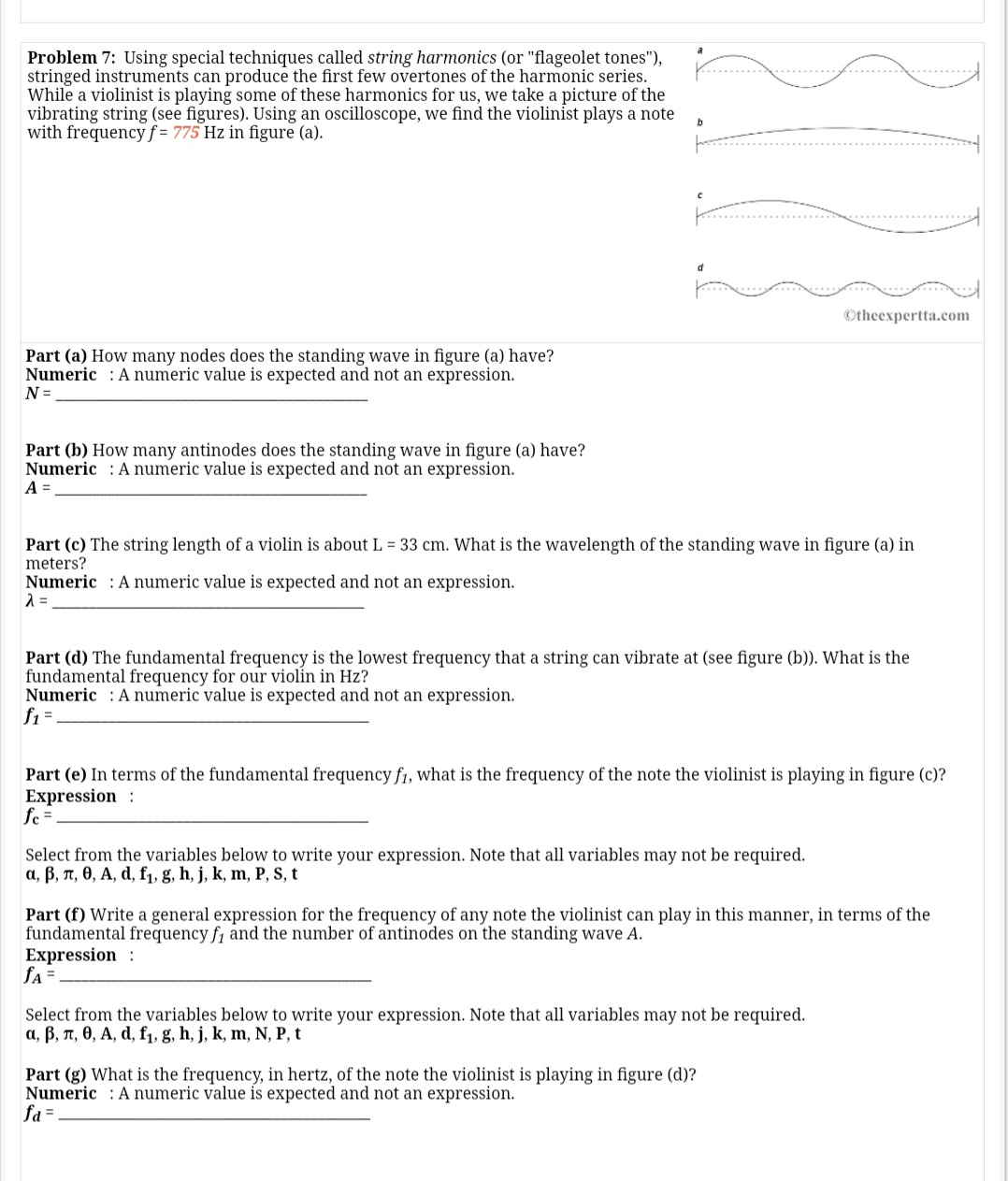Problem 7: Using special techniques called string harmonics (or "flageolet tones"), stringed instruments can produce the first few overtones of the harmonic series. While a violinist is playing some of these harmonics for us, we take a picture of the vibrating string (see figures). Using an oscilloscope, we find the violinist plays a note with frequency f = 775 Hz in figure (a). Otheexpertta.com Part (a) How many nodes does the standing wave in figure (a) have? Numeric : A numeric value is expected and not an expression. N = Part (b) How many antinodes does the standing wave in figure (a) have? Numeric : Anumeric value is expected and not an expression. A = Part (c) The string length of a violin is about L = 33 cm. What is the wavelength of the standing wave in figure (a) in meters? Numeric : A numeric value is expected and not an expression. Part (d) The fundamental frequency is the lowest frequency that a string can vibrate at (see figure (b)). What is the fundamental frequency for our violin in Hz? Numeric : A numeric value is expected and not an expression. f1 = Part (e) In terms of the fundamental frequency f1, what is the frequency of the note the violinist is playing in figure (c)? Expression : Select from the variables below to write your expression. Note that all variables may not be required. a, B, n, 0, A, d, f1, g, h, j, k, m, P, S, t Part (f) Write a general expression for the frequency of any note the violinist can play in this manner, in terms of the fundamental frequency f, and the number of antinodes on the standing wave A. Expression : fA =
Problem 7: Using special techniques called string harmonics (or "flageolet tones"), stringed instruments can produce the first few overtones of the harmonic series. While a violinist is playing some of these harmonics for us, we take a picture of the vibrating string (see figures). Using an oscilloscope, we find the violinist plays a note with frequency f = 775 Hz in figure (a). Otheexpertta.com Part (a) How many nodes does the standing wave in figure (a) have? Numeric : A numeric value is expected and not an expression. N = Part (b) How many antinodes does the standing wave in figure (a) have? Numeric : Anumeric value is expected and not an expression. A = Part (c) The string length of a violin is about L = 33 cm. What is the wavelength of the standing wave in figure (a) in meters? Numeric : A numeric value is expected and not an expression. Part (d) The fundamental frequency is the lowest frequency that a string can vibrate at (see figure (b)). What is the fundamental frequency for our violin in Hz? Numeric : A numeric value is expected and not an expression. f1 = Part (e) In terms of the fundamental frequency f1, what is the frequency of the note the violinist is playing in figure (c)? Expression : Select from the variables below to write your expression. Note that all variables may not be required. a, B, n, 0, A, d, f1, g, h, j, k, m, P, S, t Part (f) Write a general expression for the frequency of any note the violinist can play in this manner, in terms of the fundamental frequency f, and the number of antinodes on the standing wave A. Expression : fA =
Related questions
Question
can u please ans question (f) & (g)?

Transcribed Image Text:Problem 7: Using special techniques called string harmonics (or "flageolet tones"),
stringed instruments can produce the first few overtones of the harmonic series.
While a violinist is playing some of these harmonics for us, we take a picture of the
vibrating string (see figures). Using an oscilloscope, we find the violinist plays a note
with frequencyf = 775 Hz in figure (a).
©theexpertta.com
Part (a) How many nodes does the standing wave in figure (a) have?
Numeric : A numeric value is expected and not an expression.
N =
Part (b) How many antinodes does the standing wave in figure (a) have?
Numeric : A numeric value is expected and not an expression.
A =
Part (c) The string length of a violin is about L = 33 cm. What is the wavelength of the standing wave in figure (a) in
meters?
Numeric : A numeric value is expected and not an expression.
Part (d) The fundamental frequency is the lowest frequency that a string can vibrate at (see figure (b)). What is the
fundamental frequency for our violin in Hz?
Numeric : A numeric value is expected and not an expression.
f1 =
Part (e) In terms of the fundamental frequency f1, what is the frequency of the note the violinist is playing in figure (c)?
Expression :
fe =
Select from the variables below to write your expression. Note that all variables may not be required.
a, B, T, 0, A, d, f1, g, h, j, k, m, P, S, t
Part (f) Write a general expression for the frequency of any note the violinist can play in this manner, in terms of the
fundamental frequency f, and the number of antinodes on the standing wave A.
Expression :
fA =
Select from the variables below to write your expression. Note that all variables may not be required.
a, B, n, 0, A, d, f1, g, h, j, k, m, N, P, t
Part (g) What is the frequency, in hertz, of the note the violinist is playing in figure (d)?
Numeric : A numeric value is expected and not an expression.
fa =
Expert Solution
This question has been solved!
Explore an expertly crafted, step-by-step solution for a thorough understanding of key concepts.
This is a popular solution!
Trending now
This is a popular solution!
Step by step
Solved in 2 steps with 1 images
